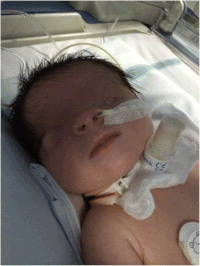
Photo from wikipedia
Purpose: Fraser syndrome is a rare congenital disorder comprising cryptophthalmos, syndactyly, and many times, urogenital anomalies. Herein, the authors aimed to study and report the clinical features and orbital anomalies… Click to show full abstract
Purpose: Fraser syndrome is a rare congenital disorder comprising cryptophthalmos, syndactyly, and many times, urogenital anomalies. Herein, the authors aimed to study and report the clinical features and orbital anomalies in cases diagnosed with Fraser syndrome. Methods: The authors retrospectively evaluated the records of patients with Fraser syndrome who had presented to a tertiary eye care hospital in northern India in the last 2 years (from January 2019 to December 2020). The clinical features were studied, entered in MS Excel, and the data was evaluated. Results: Data of 15 patients with Fraser syndrome were found. Majority of the patients were males and presented in the pediatric age group. Bilateral involvement was more common, and the most common variant of cryptophthalmos was abortive. Complete and medial madarosis of the eyebrows was the most common periocular finding. Complete cryptophthalmos was associated with cystic globes, whereas abortive forms had superior symblepharon. Common systemic features included syndactyly, bifid nose, and urogenital anomaly. Conclusion: Fraser syndrome is an extremely rare developmental disorder; it encompasses a wide range of ocular, periocular, and orbital anomalies, along with multiple pre-existing systemic anomalies. The treating ophthalmologist should always be careful in examining these patients.
Journal Title: Indian Journal of Ophthalmology
Year Published: 2022
Link to full text (if available)
Share on Social Media: Sign Up to like & get
recommendations!